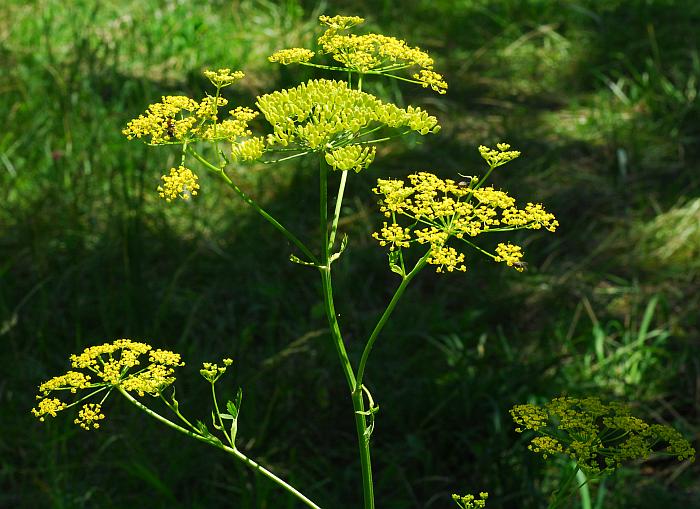Pastinaca sativa L.
Parsnip

Introduced
CC = *
CW = 5
MOC = 48
© SRTurner
Pastinaca sativa L.Parsnip | |
 |
Introduced CC = * CW = 5 MOC = 48 |
© SRTurner |
|
Family - Apiaceae Habit - Biennial forb. Stem - Ascending or erect, to 2 m, relatively stout, usually strongly ridged, glabrous to moderately short-hairy.
Leaves - Alternate and often also basal (a few basal leaves usually present at flowering), glabrous or the undersurface short-hairy, short- to long-petiolate, the sheathing bases of lower leaves slightly to moderately inflated. Blades of the basal and main leaves 5-55 cm long (uppermost leaves usually highly reduced and nearly bladeless), oblong-elliptic to ovate in outline, pinnately 1 or 2 times compound, the leaflets 10-200 mm long, lanceolate or ovate to nearly circular, narrowed to less commonly shallowly cordate at the base, toothed (often coarsely so) and often shallowly to deeply lobed, rounded or narrowed to a blunt point at the tip.
Inflorescences - Terminal and axillary, compound umbels, these sometimes appearing in loose clusters of 3 or 5, short- to long-stalked, the stalks glabrous or minutely hairy. Involucre absent. Rays 5 to numerous, 2-10 cm long, unequal in length, glabrous or minutely hairy. Involucel absent.
Florets - Flowers 8 to numerous in each umbellet, the stalks 2-10 mm long (the central flower sometimes sessile), elongated slightly at fruiting, glabrous or minutely hairy. Sepals absent. Petals 5, ovate, narrowed or tapered to a short, slender tip, this often curled inward, yellow, occasionally tinged with red. Stamens 5, the filaments free. Pistil 1 per flower, composed of 2 fused carpels, the ovary glabrous, inferior with a swollen nectar disc at the tip, the styles 2, often expanded at the base.
Fruits - Schizocarps 5-7 mm long, oblong-elliptic or broadly elliptic to slightly oblong-obovate in outline, flattened dorsally, glabrous, tan to light greenish brown with usually prominent reddish brown oil tubes between the ribs, each mericarp with the intermediate and dorsal ribs slender and nervelike, hardly raised from the surface, the lateral ribs with thin, broad wings.
Flowering - May - October. Habitat - Pastures, roadsides, fields, railroads, open disturbed areas. Origin - Native to Europe. Lookalikes - None close. Other info. - This is the species of the common culinary parsnip. It is an introduced species in Missouri, found growing wild predominantly in the northern half of the state. It occurs sporadically across the continental U.S. but is much more common in the upper Midwest and New England. It is easily recognized by its robust stature and habit, umbels of yellow flowers, and distinctive leaves. Photographs taken at Gallatin Conservation Area, Daviess County, MO, 06-13-2014; Chloe Lowry Marsh Natural Area, Mercer County, MO, 06-17-2018 and 6-20-2024; and near Fremont, Newaygo County, MI, 8-11-2022 (SRTurner). |